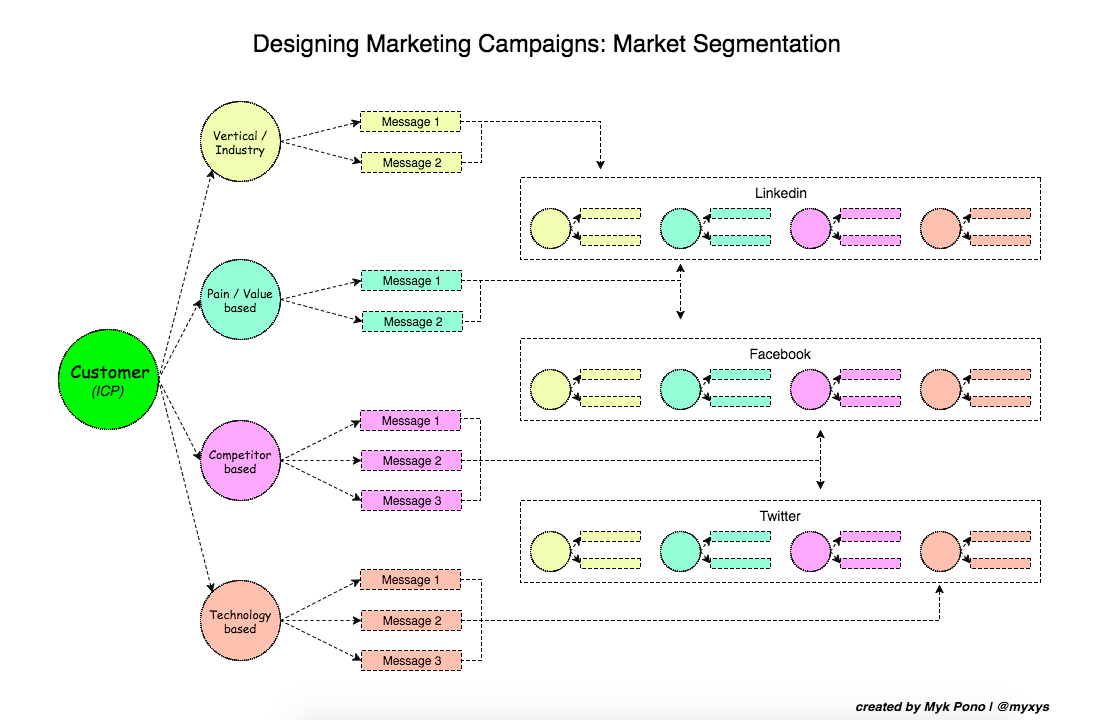Market Segmentation Fundamentals: Why Segmentation is Critical to Customer Growth
Startups have a limited budget for marketing and sales, so it's critical that sales and marketing teams prioritize who those dollars are used. This is the core reason why market segmentation is important for any founder. Market segmentation is about prioritizing your resources to achieve the largest impact with the smallest number of dollars.
Market segmentation is a data-driven exercise that founders should engage in at various points after they begin selling to customers. To figure out your market segments, your team should be looking at factors such as market size, growth rate, CAC, win rate for gaining customers, and average LTV. Based on these numbers, you can then determine your sales activities, marketing initiatives and even your product roadmap.
Here's a sample of how you might segment your market:
What if you do not use market segmentation tactics? Well, it's easy to spot a startup that doesn't think critically about the market they are going after. You might note that their marketing content is undifferentiated and unoriginal. Their company blog will contain superficial content and be completely useless to the target demographic (s). They may be selling to customers in multiple industries but never succeed at becoming the go-to solution in either one.
Where do you start with market segmentation?
Before starting a marketing campaign, your startup should have a marketing foundation. Your "marketing foundation" will allow you to stay focused, hone in on the metrics that are important, and make the right hires as your company grows. It should contain your value proposition, a list of your market segments, content topics relevant to your product, and potential marketing channels that you will be able to weigh when you actually begin segmenting your market.
You should know who your customer is, know the message you are trying to get across, and know the dynamics of the market so you can effectively position your company. With market segmentation, your goal should be to separate your customers into groups to be able to achieve the following (compiled by KJ Prince):
- Identify the highest and lowest value customers (in terms of profitability, or other factors that may influence profitability directly or indirectly).
- Identify the commonalities between cohorts (psychographic, demographic, behavioral, habits) so you can tailor your communication style, offers, design, customer experience, pricing, packaging, etc.
- Create customer profiles, buyer personas, or develop customer journey maps for various departments (sales, marketing, design, development, etc.).
- Develop a rich profile of customer data for the purpose of building look-a-like audiences (EG. identifying the common demographic, behavioral factors between your most profitable customers so you can target you marketing to similar audiences).
When you are starting the process, you should decide whether you are first focusing on top down or bottom up segmentation. This isn't an either-or approach. You'll inevitably have to think about segmentation in both ways, but at certain points in your startup journey one approach might be more useful than the other.
- Top-down segmentation startups when the product and then attempts to find the right customer segments who would pay to use that product. This approach might be better suited to a company that has invested heavily in creating a hardware product that's difficult to change or a company with a large user base that will be heavily affected changes you make to the product.
- Bottom-up segmentation is more focused on the target customer. This approach is all about investigating customer preferences and pain points. This is where you would come up with customer personas, do customer interviews, and develop customer journey maps.
In Part 2 of this series, we're going to discuss how to create customer profiles. Stay tuned.
More Resources:
Strategy for Building Customer Profiles
Silicon Valley’s Self Fulfilling Prophecy Of Mediocre Marketing


